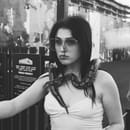Brown’s campus is notoriously beautiful—the archaic building styles, the beautiful greenery, and, during the winter, the glistening snow add to the scenery that we all know and love. However, the most exciting parts of the campus are not found in the great outdoors, but within the art installations. I will discuss a few of the pieces that reside on Brown’s campus.
‘Idee di Pietra’ (Ideas of Stone) was installed in fall of 2016 on the Main Green. This cast bronze statue, created by Giuseppe Penone, depicts a tree with a rock in it. Sometimes you come across students shaking the tree, trying to make the rock fall out— little do they know the granite stone weighs 5000 pounds! The tree is modeled after a nut tree in its color, texture, and size. “…Idee de Pietra is an elegant and contemplative reflection on the force of gravity in the natural world and the human body.”
Another bronze sculpture, ‘Reclining Figure No. 2 — Bridge Prop’, was installed many years ago on the Main Green. Sometimes, if the weather permits, you can find a student laying down inside the sculpture, reading a book or enjoying a unique view of Brown’s campus. Created by Henry Moore, this piece was inspired by the Waterloo Bridge in London, as the artist saw one part of the bridge resting upon another. It resembles the human body through its interconnections and shapely parts.
Now moving to the Quiet Green, let’s discuss Martin Puryear’s ‘Slavery Memorial,’ dedicated in 2014. Created with granite, ductile cast iron, and stainless steel, his piece recognizes Brown’s connection to the transatlantic slave trade, and to the work of free and enslaved Africans and African-Americans who helped build the university, the state, and the nation. After three years of research under the direction of former President Ruth Simmons, Brown discovered that “slavery and the slave trade were pervasive throughout Rhode Island; Rhode Island dominated the North American share of the African slave trade; the economy of the state was dependent on slavery; and Brown University was a beneficiary of this trade.” Thus, the Slavery and Justice Committee set an agenda to implement for a variety of future actions, one of which included the creation of this permanent memorial… “a living site of memory, inviting reflection and fresh discovery without provoking paralysis or shame.” The memorial consists of two parts, a sculpture and a stone plinth with text that reads, “This memorial recognizes Brown University’s connection to the transatlantic slave trade and the work of Africans and African-Americans, enslaved and free, who helped build our university, Rhode Island, and the nation. In 2003, Brown President Ruth J. Simmons initiated a study of this aspect of the university’s history. In the eighteenth century, slavery permeated every aspect of social and economic life in Rhode Island. Rhode Islanders dominated the North American share of the African slave trade, launching over a thousand slaving voyages in the century before the abolition of the trade in 1808, and scores of illegal voyages thereafter. Brown University was a beneficiary of this trade.”
Now moving to the Ruth J. Simmons Quad to discuss ‘War Memorial’ by Richard Fleischner, created of granite, marble, bronze, and planting. This memorial honors the Brown Alumni who died during the Vietnam War, the Korean War, and World War II. The lattice with a perpendicular marble slab contains the names of the alums who perished.
The latest addition to Brown’s art collection resides on the east entrance of the Environment and Society building. ‘Under the Laurentide,’ by Maya Lin, is created with granite and water, and “was commissioned in conjunction with Brown’s public commitment to advanced environmental research, responds to IBES’s activities, the region’s ecology, and Lin’s own longstanding interest in the natural world.”
Now for my personal favorite installation on campus. As a lover of Milan Kundera’s “The Book of Laughter and Forgetting”, Tom Friedman’s ‘Circle Dance’ excited me immensely when I came to visit Brown in high school. The book is centered around the idea of a circle dance, and I thought it must be a sign that I should go to Brown! Installed on The Walk, this piece was inspired by Henri Matisse’s ‘La Danse’ (1910). It was donated by an anonymous alum who wanted this piece to set an example for people to contribute to the cultural landscape of Brown.
Lastly, how could I forget “Blueno”?! The ‘Untitled (Lamp/Bear)’, better known as ‘Blueno’ by students, was created by Urs Fischer with cast bronze, acrylic glass, LED lights, and stainless steel. This piece is both 23 feet in height and width! The artist created this piece with the ideas of “the inner mechanisms of duality” and “what happens when two specific objects meet in an imagined space.” This bright blue statue is very controversial between the students on campus. Many students believe that the more-than 6 million dollar donation could have been spent towards other things for the university, while others appreciate the art. If you ask around campus, you’ll find a 50-50 split. Last year, when the snow fell and it got to be very cold, the knitting club knit a giant red scarf for Blueno to wear and keep warm.
I hope you enjoyed getting to learn a little bit about some of the public art of Brown’s campus. Before it gets too cold, go explore the campus and check out these marvelous pieces of art that engage the students in aesthetics and culture.
Citations: https://www.brown.edu/about/public-art/



